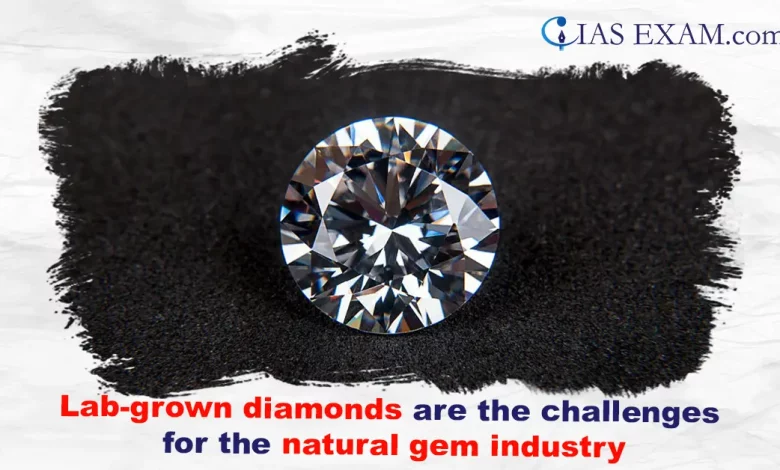Daily Current Affairs for UPSC
Lab-grown diamonds are the challenges for the natural gem industry
Syllabus: Science and technology[GS Paper-3]

Context:
- Lab-grown diamonds, which are produced artificially, are making a significant impact on the global diamond jewellery market, particularly in Surat, India.
- This city is known for cutting and polishing 90% of the world’s diamonds. From 2019 to 2022, the value of lab-grown diamond exports from India tripled, and exports increased by 25% between April and October 2023.
Key Points:
- Diamond equivalents from labs have the same sparkle as the natural gems but are significantly cheaper due to the fact that they are newly created in a laboratory as opposed to the millions of years that natural diamonds have taken to form.
- The diamonds in question are chemically and optically identical to natural diamonds.
- Described as ‘synthetic diamonds’, these types of diamonds have been around since the 1950s, but it is only recently that a process accessible to the market has been created.
Lab Grown Diamond:
- Lab-grown diamonds are becoming increasingly popular because they are cheaper and easier to produce compared to natural diamonds.
- The process involves growing crystals in a lab using carbon-containing gases, and then cutting and polishing the diamonds by hand.
- The market share of lab-grown diamonds has been steadily increasing, with exports from India seeing significant growth in recent years.
- It is expected that lab-grown diamonds will continue to gain market share in the coming years.
Statistics for global shares and exports of Diamond:
- The global diamond jewellery business, which is worth $89 billion, is wiping out the demand for mined diamonds with the growing popularity of man-made diamonds, particularly where they are sold the most, in Surat, India, which is where most of the world’s rough diamonds are cut.
- The valuation of the lab-grown diamond exports from India has risen by triple times between 2019-2020, along with the volume of export increased by 25% from April to October 2023.
- The percentage of lab-grown gems in the market has reached 5% in 2018 which is now 18.5% in 2023. This year it is expected to surpass 20%
- In the meantime, all of this has put additional pressure on the natural gem industry that has to deal with geopolitical problems and declining demand for gemstones.
Impact of humanitarian and environmental concerns:
- The Kimberley Process ensures that conflict diamonds are kept out of the market by using lab-grown diamonds.
- Natural diamonds have an environmental impact due to energy-intensive processes and carbon-heavy electricity sources, but there is a move towards using green energy like solar power.
- Because of these reasons, lab-grown diamonds have become a popular choice for engagement rings.
Global Status of Diamond:
- In February 2023, the U.S., the largest consumer of natural diamonds, saw a significant increase in the use of lab-grown gems in engagement rings, rising from 17% to 36%.
- This shift has been attributed to a combination of factors, including increased exports of lab-grown diamonds from India and a decrease in demand for natural diamonds following the COVID-19 pandemic.
Reason behind the decline of natural gemstones:
- The natural diamond industry is confronting several problems including competition from the lab-grown diamonds, falling economic growth in major markets as the USA and China, oversupply and the international sanctions against Russian rough-cut diamonds.
- As counter measures to these challenges, the Indian processed diamond industry voluntarily has banned imported rough diamonds.
- The synthetic diamond industry has been growing at a very fast rate nowadays due to which its supply has become sizable and consequently its price has fallen dramatically.
- Nevertheless, this stagnation in prices is forecasted to encourage demand and subsequently result in a general decrease in prices too, since there isn’t a monopoly in the industry.
Conclusion:
- The rise of lab-grown diamonds in the jewellery industry is leading to a more sustainable and ethical future.
- However, there are obstacles such as consumer doubt and the need for a transparent supply chain.
- By educating consumers, promoting transparency, and embracing innovation, lab-grown diamonds can have a positive impact on the environment and society.
Source: The Hindu
UPSC Prelims Practice Question:
Q.With reference to the Lab Grown Diamonds, consider the following statements
- These are diamonds which are grown inside a lab using cutting-edge technology.
- These diamonds are chemically, physically, and optically different from natural diamonds.
- These diamonds are used in computer chips and satellites.
Which of the statements given above is/are correct?
a.1 and 2 only
b.2 and 3 only
c.1 and 3 only
c.2 and 3 only
Ans: “a”





.png)



